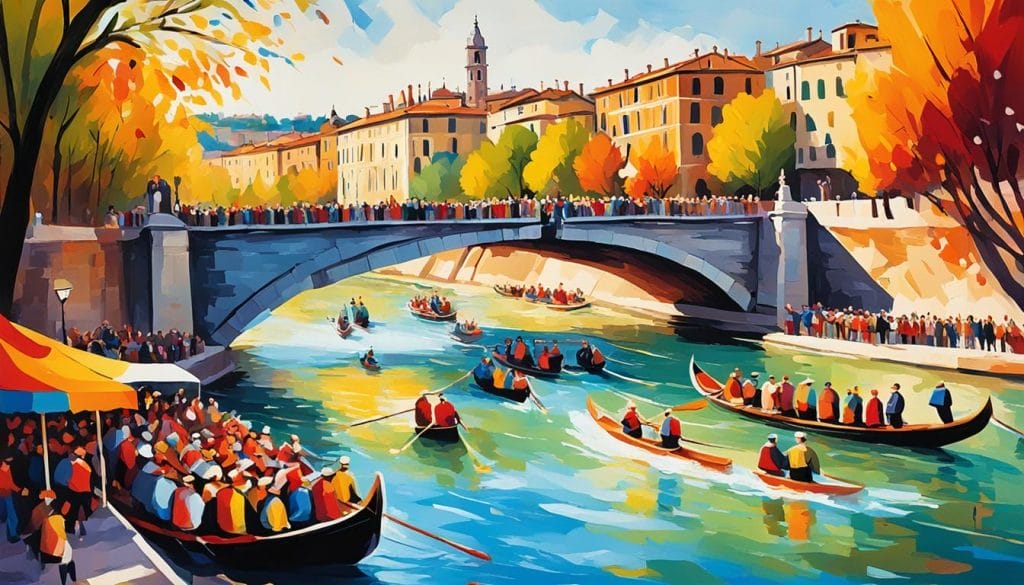Did you know that the Tiber River flows through iconic locations in Rome, connecting historical landmarks such as Piazza Navona, the Vatican, and the Colosseum? This ancient river, steeped in history and legend, has played a pivotal role in the development of the Eternal City. From serving as the border between different ancient Roman regions to being an essential part of the city’s economy and transportation system, the Tiber River holds an undeniable importance in Rome’s story. Let’s dive into the fascinating facts and captivating beauty of the Tiber River.
Key Takeaways:
- The Tiber River flows through iconic locations in Rome, connecting historical landmarks.
- The river served as a border between different ancient Roman regions.
- The Tiber River played a crucial role in Rome’s economy and transportation system.
- Boat trips along the Tiber offer a unique perspective of Rome and its historical sites.
- The Tiber River adds to the historic charm of Rome, captivating artists, poets, and locals.
The Importance of the Tiber River in Ancient Rome
In ancient Rome, the Tiber River played a crucial role in the city’s economy and transportation system. It served as a border between different regions and facilitated the movement of merchant ships carrying goods and provisions to the capital. The river was also a strategic asset during wars, including the Punic Wars, where the port of Ostia on the Tiber was instrumental in sea battles.
The Tiber River was not only significant for trade and military purposes but also for its role in the city’s infrastructure. It was an integral part of the Roman central sewer system, channeling clean water into the city and ensuring proper sanitation. Its waters were used for drinking, bathing, and as a vital resource in daily life.
“The Tiber River was the lifeblood of ancient Rome, connecting the city to the wider world and providing essential resources for the growing empire.” – Ancient Rome expert
Over time, the river’s importance in transportation declined as it became shallower, making navigation more difficult. However, the historical significance of the Tiber River in ancient Rome remains undeniable. It holds a special place in the city’s history and culture, with countless references in art, literature, and historical accounts.
The Tiber River continues to be a cherished symbol of Rome’s rich heritage, attracting visitors from around the world who are intrigued by its historical significance and the beauty of its surroundings.
The Strategic Role of the Tiber River
The Tiber River played a significant strategic role in ancient Rome. Its presence acted as a natural barrier, separating different regions and marking distinct territories. This geographical divide provided the city with a sense of identity and security.
During wars, the Tiber River’s location made it a valuable asset for the Roman military. The port of Ostia, situated at the mouth of the river, served as a crucial naval base and played a pivotal role in sea battles. The river’s proximity to the city allowed for efficient transportation of troops, supplies, and goods, contributing to Rome’s military dominance.
The Tiber River and Roman Civilization
The Tiber River was not merely a physical entity in ancient Rome; it was intertwined with the city’s civilization. The river served as a focal point for social interactions, trade, and cultural activities. It provided a means of transportation for people and goods, connecting different neighborhoods and facilitating the exchange of ideas and resources.
Furthermore, the Tiber River was an integral part of Rome’s religious practices. According to ancient Roman beliefs, the river was considered sacred and was associated with various deities, including Tiberinus, a god of the river. Festivals and rituals were held along its banks, paying homage to the river’s importance in Roman mythology and spirituality.
The Tiber River Today
While the importance of the Tiber River in ancient Rome may have diminished over time, its legacy continues to shape the city’s character. Today, the river serves as a reminder of Rome’s rich history and heritage, attracting tourists and locals alike.
Visitors can stroll along the river’s banks, taking in breathtaking views of iconic landmarks such as the Vatican and Castel Sant’Angelo. Boat trips along the Tiber offer a unique perspective of Rome, providing glimpses of historical sites and allowing visitors to appreciate the city from a different vantage point.
The Tiber River remains a vital symbol of Rome’s past, present, and future, connecting generations and weaving together the threads of history that make the Eternal City truly extraordinary.
The Geography and Features of the Tiber River
The Tiber River is more than just a body of water in Rome; it’s a geographical and historical landmark that has shaped the city’s identity. Spanning a length of 406 kilometers (252 miles), the Tiber originates in the Apennine Mountains of Emilia-Romagna and meanders through the picturesque regions of Umbria and Lazio before reaching Rome.
With a basin area of 17,375 square kilometers (6,709 square miles), the Tiber River serves as a vital water supply for the city of Rome, nourishing its people and its rich history. It is the third longest river in Italy, making its mark on the landscape and the collective memory of the Roman people.
Known affectionately as “flavus,” the Tiber River’s waters showcase a distinct yellow-whitish hue. This unique characteristic adds to the charm and mystique of this historic river, captivating the hearts of locals and tourists alike.
The Tiber River is not without its challenges, as occasional flooding has tested the resilience of Rome over the centuries. To combat this natural phenomenon, the city constructed imposing stone walls along the riverbanks in the 19th century. These formidable barriers not only control the flow of the river but also protect the city from potential floodwaters.
Experience the majesty of the Tiber River as you explore Rome, taking in its breathtaking views, storied past, and natural beauty. Whether you’re walking along its banks or cruising along its tranquil waters, the Tiber River offers an unparalleled connection to the history and geography of this timeless city.
The Bridges of the Tiber River
The Tiber River is famous for its bridges, some of which date back to ancient Roman times. These bridges not only provide practical crossings but also serve as architectural and historical landmarks in the city.
Ponte Cestio and Ponte Fabricio are two ancient bridges that are still accessible today. These bridges showcase the remarkable engineering and craftsmanship of the ancient Romans.
Ponte Sant’Angelo, also known as the Bridge of Hadrian, is a stunning bridge that offers breathtaking views of St. Peter’s Basilica. It holds immense historical significance and leads to the majestic Castel Sant’Angelo.
Ponte Milvio, built in the 1st century BC, is not only a functional bridge but also a popular meeting place for young Romans. It has a vibrant atmosphere and is adorned with love locks, symbolizing everlasting love.
| Bridge | Location | Historical Significance |
|---|---|---|
| Ponte Cestio | Across the Tiber River | Ancient Roman bridge, still accessible today |
| Ponte Fabricio | Across the Tiber River | Oldest Roman bridge still in use |
| Ponte Sant’Angelo | Across the Tiber River, leading to Castel Sant’Angelo | Built by Emperor Hadrian, offers stunning views of St. Peter’s Basilica |
| Ponte Milvio | Across the Tiber River | Popular meeting place, adorned with love locks |
Quote:
“The bridges of the Tiber River not only connect different parts of the city but also serve as testaments to Rome’s rich history and architectural prowess.” – Anonymous
These bridges are not just functional structures but also embody the spirit of Rome and its enduring legacy. They are a testament to the ingenuity and artistic sensibilities of ancient civilizations, offering visitors a glimpse into the grandeur of the past.
Tiber River Tourism and Cruises
The Tiber River offers a multitude of tourism opportunities that allow visitors to explore Rome’s historical sites from a unique perspective. One of the most popular ways to experience the Tiber is through boat trips, which provide breathtaking views of the city and its iconic landmarks.
Starting from Ponte Sant’Angelo or Ponte Marconi, these boat trips take you on a journey along the Tiber, offering panoramic vistas of St. Peter’s Basilica and the opportunity to explore the excavations of Ostia Antica and the mouth of the river in Fiumicino.
These cruises not only allow you to appreciate the beauty of Rome’s architectural heritage but also offer a chance to immerse yourself in the diversity of flora and fauna that thrives along the river. From the comfort of the boat, you can observe the lush greenery that lines the Tiber’s banks and spot various bird species that call the river their home.
For those who prefer a more active experience, the Tiber River offers the Lungotevere, a long cycle path that runs parallel to the river. This scenic route is perfect for leisurely walks, invigorating jogs, or peaceful cycling excursions, providing a serene escape from the bustling city.
Whether you choose to embark on a boat trip or explore the Lungotevere, the Tiber River offers a range of options for tourists seeking to delve into Rome’s rich history and natural beauty. Discover the magic of the Tiber and let it guide you on a memorable journey through the heart of the Eternal City.
| Benefits of Tiber River Tourism: | Highlights of Tiber River Cruises: |
|---|---|
|
|
Explore Rome’s rich heritage from the tranquil waters of the Tiber River. Whether you choose a leisurely boat trip or a peaceful stroll along the Lungotevere, the Tiber River promises a captivating experience that will leave you with lasting memories of the Eternal City.
Tiber River and Rome’s Historic Charm
The Tiber River holds a significant place in the heart of Rome, contributing to the city’s historic charm that continues to awe artists, poets, and locals alike. Legend has it that Rome itself was founded on the banks of the Tiber River, solidifying its deep-rooted connection with the city’s identity. In ancient Rome, the Tiber acted not only as a natural border between different regions but also as a vital element of the city’s economy and transportation system. It played a pivotal role in facilitating the movement of merchant ships, carrying goods and provisions to Rome. The river’s importance extended beyond commerce, as it served as a crucial component of the Roman central sewer system, providing clean water to the city.
Today, the Tiber River stands as a testament to Rome’s rich history and ancient heritage. Taking a leisurely stroll along its paths offers a transformative experience, immersing visitors in the layers of history that have shaped the city’s character. The picturesque surroundings, coupled with the gentle flow of the Tiber, create an ambiance that resonates with the vibrant spirit of Rome. It’s a chance to reflect upon the past and witness the enduring influence of the Tiber River on the city’s architectural, cultural, and artistic landscape.
The Tiber River, with its centuries-old stories woven effortlessly into the fabric of Rome, epitomizes the city’s timeless allure. Its presence evokes a sense of awe and wonder, offering a glimpse into the ancient world that once thrived along its banks.
Walking alongside the Tiber River enables visitors to connect with the traditions and legends that have shaped Rome’s identity throughout the centuries. It is a path marked by archaeological marvels, magnificent bridges, and historic landmarks that stand as a testament to the city’s enduring legacy. As one embarks on this reflective journey, the captivating allure of Rome’s historic charm unfolds, leaving an indelible impression on all who experience it.
Strolling Down Lungotevere: A Riverside Itinerary
The Lungotevere, the picturesque pathways along the Tiber River, offer the perfect setting for a leisurely stroll, allowing visitors to explore a multitude of landmarks and sights. Start your riverside journey from Isola Tiberina, where you can immerse yourself in the remnants of Ponte Rotto, an ancient bridge with a unique history. As you continue along the Lungotevere, you’ll encounter the charming Ponte Sisto, known for its stunning views and romantic atmosphere. Further ahead, the iconic Castel Sant’Angelo awaits, inviting you to delve into its intriguing architecture and historical significance.
Continuing your walk towards Vatican City, the majestic St. Peter’s Basilica comes into view, captivating visitors with its grandeur. Cross Ponte Milvio, a bridge steeped in history, and venture into the northern stretches of the city, where hidden gems await. Discover the awe-inspiring Villa Farnesina, a historical villa adorned with remarkable frescoes, showcasing the artistry of the Renaissance period. And don’t forget to marvel at the Ministry of Justice, a notable architectural landmark that adds to the charm of the Lungotevere.
Highlights Along the Lungotevere:
- Isola Tiberina – Explore the remnants of Ponte Rotto, an ancient bridge with a unique history.
- Ponte Sisto – Take in the stunning views and romantic atmosphere of this picturesque bridge.
- Castel Sant’Angelo – Delve into the intriguing architecture and historical significance of this iconic fortress.
- St. Peter’s Basilica – Be captivated by the grandeur of one of the world’s most famous basilicas.
- Ponte Milvio – Cross this historic bridge and venture into the northern stretches of the city.
- Villa Farnesina – Discover the remarkable frescoes that adorn this historical villa.
- Ministry of Justice – Marvel at this notable architectural landmark along the Lungotevere.
As you stroll down the Lungotevere, take in the scenic beauty of the Tiber River and let the rich history of Rome unfold before your eyes. This riverside itinerary offers a delightful way to explore the city, immersing yourself in its architectural marvels, historical treasures, and enchanting atmosphere.
Cultural Events by the Tiber
Each summer, the Tiber River comes alive with the “Lungo il Tevere” festival, transforming the riverbanks into a vibrant hub of activity. The festival features pop-up restaurants, cinema screenings, and stalls selling various goods. It offers a unique opportunity to immerse oneself in the lively atmosphere of Rome and experience the city’s cultural scene. The Tiber River, with its riparian legacy, serves as the backdrop for these cultural events, providing an enchanting setting for locals and tourists to enjoy.
With the Lungo il Tevere festival, the Tiber River becomes the stage for a captivating display of Rome’s artistic and culinary offerings. The glittering lights reflecting off the water create a magical ambiance that beckons visitors from around the world. Whether you’re a food lover looking to indulge in delicious street delicacies or an art enthusiast eager to immerse yourself in open-air cinema screenings and exhibitions, Lungo il Tevere has something for everyone.
“Lungo il Tevere brings the city to life, creating an electric atmosphere that celebrates Rome’s rich cultural heritage. From live music performances to art installations, the festival showcases the creativity and diversity of the city,” says Alessandro Rossi, a local artist.
Strolling along the Tiber River during the festival, you’ll encounter a myriad of vibrant colors, tantalizing aromas, and an overwhelming sense of joy. Explore the stands selling handcrafted jewelry, fashion, and vintage treasures, or simply relax at one of the riverside bars and cafés while listening to live music performances.
Immerse yourself in the cultural tapestry of Rome by attending the various artistic and musical events held during Lungo il Tevere. From jazz concerts to poetry readings, these events showcase the thriving creative scene that thrives along the Tiber River. The festival truly captures the essence of Roman culture and invites visitors to become a part of the city’s vibrant atmosphere.
Whether you’re strolling along the riverbanks, enjoying a picnic with breathtaking views of the water, or engaging in the lively festivities of the Lungo il Tevere festival, the Tiber River presents a unique opportunity to experience the cultural vibrancy of Rome. It serves as more than just a geographical feature; it’s a testament to the city’s rich history and its ability to continually reinvent itself as a cultural epicenter.
Experience the magic of Lungo il Tevere and soak in the cultural events by the Tiber River, where art, music, and culinary delights come together in perfect harmony.
Rome’s Riparian Legacy
The Tiber River holds more than just a place on Rome’s map. It has witnessed the rise and fall of empires, standing as a testament to the riparian history of Rome. Walking alongside the Tiber, visitors can connect with the city’s rich layers of history and immerse themselves in its enduring legacy.
The Tiber River provides a welcomed contrast to the bustling city, offering a serene and timeless elegance. It acts as a haven for peaceful contemplation, allowing people to explore Rome at a slower pace, away from the hurried rhythm of modern life.
“The Tiber River is a flowing tapestry of Rome’s past, guiding visitors through centuries of history and culture.”
From the Tiber’s gentle flow to its picturesque bridges, the river captivates with its beauty and significance. Rome’s riparian legacy is evident in every ripple and reflection along the Tiber’s shores, enticing visitors to engage with its story and embrace the allure of the river.
Discover Rome’s Riparian Heritage:
- Take a leisurely walk alongside the Tiber River
- Experience the tranquility while strolling through riverside parks
- Pause at the iconic bridges and marvel at their architectural splendor
- Enjoy a boat trip along the Tiber and see Rome from a different perspective
Exploring Rome’s riparian legacy promises an intimate and meaningful journey through the heart of the city. As you follow the flow of the Tiber River, allow its riparian history to guide you and discover Rome’s enduring allure.
Experience the riparian legacy of Rome along the picturesque Tiber River.
Conclusion
The Tiber River is an integral part of Rome’s history and beauty. From its mythological origins to its role in ancient Rome’s empire as a vital waterway, the Tiber has left an indelible mark on the city. Walking along the Lungotevere, visitors can discover the iconic bridges, explore historical landmarks, and bask in the tranquility of the river. Whether enjoying a boat trip along the Tiber or participating in cultural events by its banks, the Tiber River offers a unique perspective of Rome’s rich heritage. Embrace the allure of the Tiber River and explore the captivating city of Rome.
FAQ
What is the significance of the Tiber River in Rome’s history?
The Tiber River is closely intertwined with the history and culture of Rome. According to legend, Rome was founded on its banks, and throughout the centuries, the river has played a pivotal role in the city’s development.
Where is the Tiber River located?
The Tiber River originates in the Apennine Mountains of Emilia-Romagna and flows through Umbria and Lazio before reaching Rome.
What are some iconic landmarks along the Tiber River?
The Tiber flows through various iconic locations in Rome, connecting historical landmarks such as Piazza Navona, the Vatican, and the Colosseum. It is also home to the Tiber Island, the only urban island in Rome, which houses one of the oldest hospitals in the city.
Are there any ancient bridges on the Tiber River?
Yes, the Tiber River is famous for its bridges, some of which date back to ancient Roman times. Ponte Cestio and Ponte Fabricio are two ancient bridges that are still accessible today. Ponte Sant’Angelo, also known as the Bridge of Hadrian, offers stunning views of St. Peter’s Basilica and leads to Castel Sant’Angelo. Ponte Milvio, built in the 1st century BC, is a popular meeting place for young Romans.
What tourism opportunities does the Tiber River offer?
The Tiber River offers various tourism opportunities, including boat trips that provide a unique perspective of Rome’s historical sites. Starting from Ponte Sant’Angelo or Ponte Marconi, visitors can enjoy breathtaking views of St. Peter’s Basilica and even reach the excavations of Ostia Antica and the mouth of the Tiber in Fiumicino. These boat trips allow tourists to appreciate the diversity of flora and fauna along the river and explore Rome’s unparalleled archaeological heritage.
How does the Tiber River contribute to Rome’s historic charm?
The Tiber River adds to the historic charm of Rome, with its presence influencing the city’s atmosphere and captivating artists, poets, and locals. According to legend, Rome was founded on the Tiber’s banks, and it served as a border between different ancient Roman regions. The river played a significant role in Rome’s economy, transportation, and even the central sewer system. Today, walking along the Tiber’s paths offers a reflective journey through the layers of history that shape Rome’s character.
What can I see while strolling along the Tiber River?
Strolling along the Tiber River allows visitors to discover iconic bridges, explore historical landmarks, and bask in the tranquility of the river. Starting from Isola Tiberina, visitors can explore the remnants of Ponte Rotto, the picturesque Ponte Sisto, and the iconic Castel Sant’Angelo. Continuing towards Vatican City, St. Peter’s Basilica comes into view, and crossing Ponte Milvio leads to the northern stretches of the city. Along the way, visitors can also discover historical villas, such as Villa Farnesina, and notable architectural landmarks like the Ministry of Justice.
Are there any cultural events by the Tiber River?
Each summer, the Tiber River comes alive with the “Lungo il Tevere” festival, transforming the riverbanks into a vibrant hub of activity. The festival features pop-up restaurants, cinema screenings, and stalls selling various goods. It offers a unique opportunity to immerse oneself in the lively atmosphere of Rome and experience the city’s cultural scene.
What is the riparian legacy of the Tiber River in Rome?
The Tiber River has witnessed the rise and fall of empires, making it more than just a water body in Rome’s geography. Walking alongside the Tiber allows visitors to connect with the city’s layered history and appreciate its riparian legacy. The river’s serenity and timeless elegance provide a contrast to the bustling city, offering a space for peaceful contemplation and a chance to explore Rome at a slower pace.
Source Links
- https://rome.us/ancient-rome/the-tiber-river.html
- https://www.turismoroma.it/en/page/river-tiber
- https://www.romeonfoot.com/exploring-the-tiber-and-its-scenic-spots/





